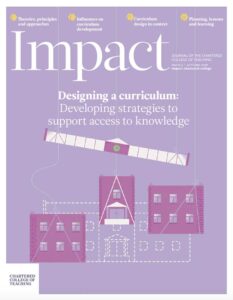Designing a secular religious studies curriculum

The Religious Education Council has warned that without good religious education (RE) teachers, religious discrimination could rise. Yet, 2017–18 saw a third of training places for initial teacher trainingAbbreviated to ITT, the period of academic study and time in... More in RE unfilled (Sellgren, 2018). This is perhaps symptomatic of one of the deeper problems with RE: a lack of clarity about the purpose, disciplinary methods and content that should be taught through the subject (Georgiou and Wright , 2018).
Two years ago, I was in the lucky position of designing a religion curriculum from scratch. I had joined East London Science School, a free school that was committed to teaching religion through a knowledge-rich curriculum. By ‘knowledge-rich’, the school meant that the intrinsic worth of the content should take precedence over teaching generic skills. Gaining knowledge is empowering because it allows students to make sense of a complex world (Young , 2009). Below, I explain my efforts to develop a knowledge-rich curriculum that resolves some of the confusion at the heart of the subject, avoiding the pitfalls of either teaching content simply because it was traditional or teaching disparate facts superficially in an effort to equip students for society.
The planning process
Summer Turner’s research provided the structure for designing the curriculum. In Secondary Curriculum and Assessment Design, Turner lays out a seven-step strategy to design a curriculum: 1) determine the purpose, 2) decide on the key principles, 3) set the expectations, 4) determine the big ideas, 5) determine the content, 6) determine the sequence, 7) review (Turner, 2016).
Purpose
Turner explains that the purpose of the curriculum ‘should represent you and the school’. Two relevant aspects of the school’s vision were ‘the best pupils are open to questioning their own thought’ and ‘we can judge our success by the impact our pupils have on the world’. Consequently, the curriculum would need to foster self-reflection and offer students content that challenged their thinking. The curriculum purpose that was developed was to enable students to appreciate how the metaphysically inaccessible can affect human behaviour. ‘The metaphysically inaccessible’ should be understood as entities or forces that religions posit exist yet there is no verifiable method of evidencing their existence. Examples could include the afterlife, souls or karma. The purpose represents both my and the school’s values, as it establishes its goal of students becoming reflective about the complex nature of religions. If the purpose was achieved it would empower students, because they would have a nuanced understanding of religions in the face of the reductive generalisations and simplistic narratives plaguing the image of religion in the popular press.
Principles
Determining the key principles within RE is difficult because it lacks clear disciplinary foundations. Religion is shaped by disciplines including theology, philosophy, history and the various social sciences, each of which has its own conventions. Richard Kueh argues that the multidisciplinary approach of RE should be embraced (Kueh , 2018). Consequently, the curriculum principles I developed were determined by the subject’s purpose and each discipline’s method of enquiry. The first principle was that each religion deserved to be studied on its own terms. This way, the theology of each religion would get the position it deserved in order to explain each religion’s internal logic. A second curriculum principle was that each religion should be assessed through its historical and sociological context. Finally, in order for students to appreciate how the metaphysically inaccessible can influence behaviour, students needed to understand a repertoire of several different religions. So, a third, guiding principle was that students should study a range of religions in detail across Key Stage 3.
Expectations and big ideas
Establishing the curriculum’s expectation involved considering what people with expertise on religion can do. One thing that experts have in common is that they are well informed. Perhaps more meaningful than the number of facts they know is their ability to conceptualise and categorise knowledge in different ways (Willingham , 2009). Crucially for RE, this involves being able to distinguish the aspects that make up religions. This ability is built into the curriculum’s purpose as it presupposes a distinction between a religion’s metaphysics and its ritualistic or ethical aspects. This, then, shaped the curriculum’s big ideas, which were sourced in Ninian Smart’s influential The World’s Religions (Smart, 1989), where he outlines seven dimensions of religions. Smart’s approach is controversial because belief systems that would traditionally not be seen as religions, such as Soviet Marxism, can fall under his definition. However, an inclusionary definition of religion is appropriate for a curriculum, as debates about what belief systems are on the definitional fringes are in themselves educative. I did, however, adapt Smart’s dimensions in order to achieve greater clarity for Key Stage 3 students. So, the big ideas that would shape the curriculum were also the aspects of a schema that I wanted the students to develop. These big ideas were: a) religious narrative, b) metaphysics, c) doctrines, d) institutional aspects, e) ethics, and f) rituals. These ideas would underpin the curriculum and its delivery would be structured around them.
Content
With the big ideas established, the content of the curriculum could be planned. Didau and Rose explain that ‘the most important difference between an expert and a novice is that a novice hasn’t had the time or opportunity to build up the schemas of an expert’ (Didau and Rose, 2016). As a result, the content had to be planned to provide the opportunities for the schema of the big ideas to develop. Schemas cannot simply be imposed on students; instead, students initially need to learn concrete examples. Or, as Turner explains, whilst the big ideas are ‘the skeleton, the knowledge… is the flesh and muscle’ (2016, p. 114). So, each half term, students would learn about a religion and then each lesson would focus on one of the big ideas. For example, to teach Hinduism, individual lessons would focus on Hindu rituals: puja; Hindu narrative: the Ramayana; etc.
Sequence
Regarding sequencing the curriculum, there were three major considerations. Firstly, what best served the coherence of the subject? Secondly, how could we use cognitive scienceThe study of the human mind, such as the processes of though... More to support students in remembering the content? Thirdly, we needed to consider school-based factors. Conveniently, the first and second considerations were mutually supportive. To develop expertise, students needed to categorise the content using the big ideas and under a schema for each religion. So, each religion would receive a dedicated half term where the theology of that religion would be studied. Running through each of these half terms would be the strands of the big ideas. To support the spacing and interleavingAn approach to learning where, rather than focusing on one p... More of the content, the following half term would assess the same religion. Thus, content could be revisited in order to boost the likelihood of it being stored in long-term memory (Firth, 2018). A final consideration was school-based factors. Given the school’s commitment to tolerance in the face of extremism, the leadership wanted the curriculum to address myths and media-misrepresentations of Islam early in a student’s education. Despite this being an instrumental justification for the sequence, it would not seriously undermine the subject’s coherence, so half term one of Year 7 was Islam and half term two was assessing Islam. To see the fully mapped curriculum, visit my blog at deskilledteacher.wordpress.com.
Review
The review process should be constant, although it is helpful to have periodical formal reviews with the whole department and outsiders. During these reviews, it is crucial to remember that no curriculum is perfect and time is severely limited. The school’s two-year Key Stage 3 reduced the content that the curriculum could cover and the lesson time that could be dedicated to contemplating major questions. If the school had offered a three-year Key Stage 3 then the knowledge could have been consolidated by approaching the content from different angles, like how different disciplines understand the relationship between truth and narrative. However, our reviews, so far, have concluded that the current curriculum stands the best chance of equipping our students with powerful knowledge.










